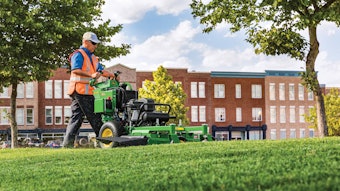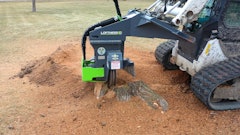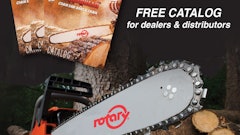
One of the major causes of tree failure is root damage. When a tree's root system has been extensively damaged, the whole tree can fall to the ground—or onto your house.
"Most homeowners look up to assess the trees in their landscape," notes Tchukki Andersen, BCMA, CTSP* and staff arborist with the Tree Care Industry Association (TCIA). "Unfortunately, a significant amount of the information on tree health and structural integrity lies unseen below ground."
Trees may fall over because the roots can no longer anchor their weight. In the urban and suburban landscape, roots can be lost or damaged by excavation, trenching, soil compaction, excess fill, paving, fungal decay, or environmental stresses such as drought or flooding.
"Some of the indicators of root problems can be detected by homeowners, while others can only be diagnosed by a professional arborist using specialized examination methods," says Andersen.
Common symptoms. Homeowners should look for signs and symptoms that could indicate root problems. Common symptoms include decline in the tree canopy, usually starting at the top but occasionally affecting one side or major branches throughout the canopy. A tree with an increasing lean, especially with soil heaving around its base, is another sure symptom of root problems. Signs of root problems include dead roots, broken roots and presence of fungal fruiting bodies (mushrooms) at the base of the tree or radiating out from the base.
On the way down ... causes of root damage
Sometimes it is obvious that utility trenches, repaving, grading or soil compaction occurred in the tree's root zone. To determine how the root damage might affect the health of the tree, a professional arborist can estimate how much of the rooting area was affected within the Critical Root Zone (CRZ). The CRZ is a circular area around the stem of the tree, usually smaller than the area defined by the outer reaches of the tree's branches, known as the drip line.
Think of the tree as both a structure and a living organism. As a rule of thumb, up to 40% of the root system can be damaged—causing problems for the living organism—before the tree's structure is seriously impaired. Conversely, the tree can be biologically healthy while the main roots it counts on for support are deteriorated. Factors to consider include a leaning tree, direction of prevailing winds relative to decayed roots, and soil conditions.
It can be difficult to assess damage to the root system. A tree may have a restricted root system because of impervious soils, or limited space to grow due to buildings or sidewalks. If new curbs or sidewalks were installed or trenches dug for utilities, essential roots could have been damaged or removed during the construction. If any of the main roots inside the CRZ are damaged or missing, the risk of tree failure is greatly increased.
What can you do?
Be on the lookout for the signs and symptoms of root damage. These symptoms can be subtle, even undetectable to the untrained eye.
A professional arborist can accurately diagnose root problems and potentially take corrective action. To find a professional arborist, contact the Tree Care Industry Association, a public and professional resource on trees and arboriculture since 1938. It has more than 2,000 member companies who recognize stringent safety and performance standards and who are required to carry liability insurance.
TCIA has the nation's only Accreditation program that helps consumers find tree care companies that have been inspected and accredited based on: adherence to industry standards for quality and safety; maintenance of trained, professional staff; and dedication to ethics and quality in business practices.
An easy way to find a tree care service provider in your area is to use the "Locate Your Local TCIA Member Companies" program. You can use this service by calling 1-800-733-2622 or by doing a ZIP Code search on www.treecaretips.org.
*Board Certified Master Arborist, Certified Treecare Safety Professional


























